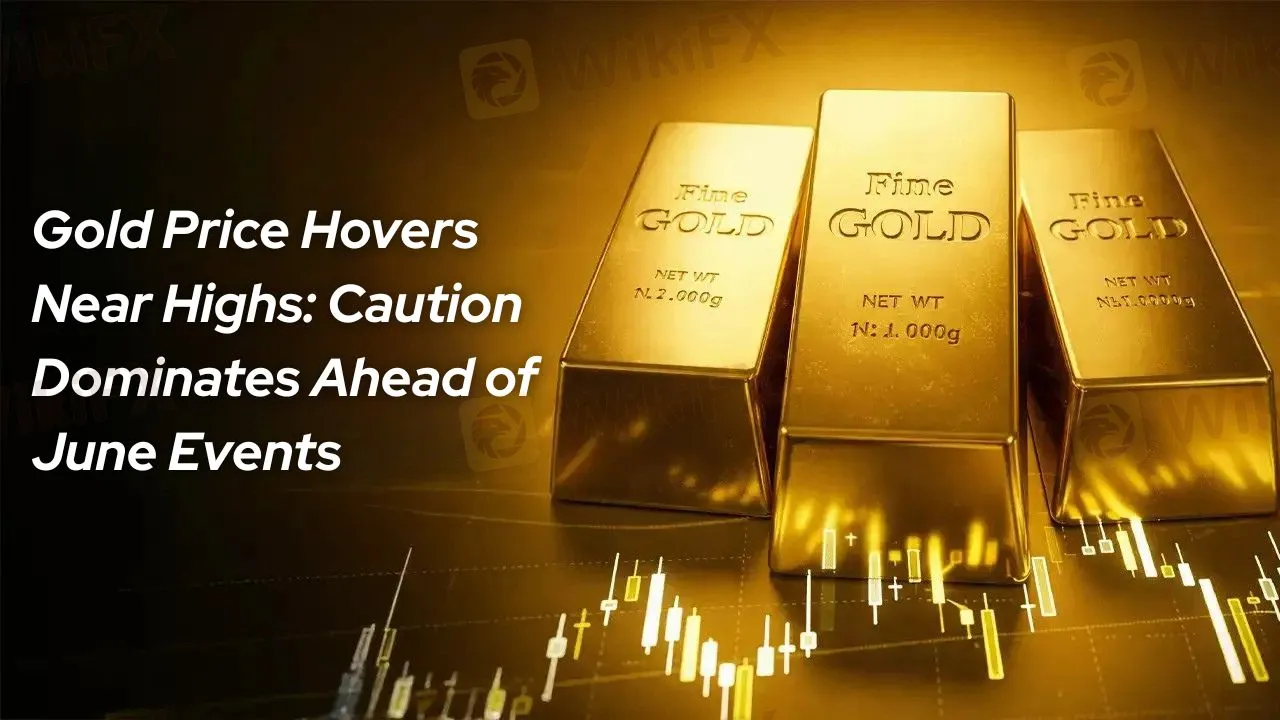简体中文
繁體中文
English
Pусский
日本語
ภาษาไทย
Tiếng Việt
Bahasa Indonesia
Español
हिन्दी
Filippiiniläinen
Français
Deutsch
Português
Türkçe
한국어
العربية
Gold Price Hovers Near Highs: Caution Dominates Ahead of June Events
Abstract:Despite losing steam in April, gold prices remain elevated. The market is now waiting for the next breakout trigger, with inflation, the Fed, and global trade all in focus.

Gold has spent most of May 2025 hovering around historically high levels, with recent prices stabilizing near $3,344 per ounce. While the early-year momentum appears to have slowed, the market remains supported by a mix of global economic caution, currency weakness, and central bank hesitation.
From early January to April, gold surged over 30% on expectations of easier U.S. monetary policy and softer inflation. After peaking above $3,400, the metal entered a corrective phase in mid-April before regaining ground in late May.
Market Conditions: Calm Outside, Tension Inside
Although the price range has narrowed over the past few weeks, traders remain alert. Gold continues to trade within a relatively tight channel, with support forming near $3,200 and resistance holding near $3,400. The lack of directional momentum does not reflect a lack of uncertainty—if anything, markets are on pause ahead of key macro triggers.
A number of unresolved external risks, including cross-border trade disagreements and upcoming economic data releases, are keeping gold investors cautious. While these developments have not yet caused a breakout, they remain part of the underlying support for golds current levels.
U.S. Inflation Cooling, But Fed Unmoved
Data released in May confirmed that U.S. inflation is slowing, with the April consumer price index coming in at 2.3% year-on-year, the lowest since early 2021. However, despite the improving inflation outlook, the U.S. Federal Reserve has not yet signaled a near-term interest rate cut.
Earlier in the year, markets had priced in potential easing by summer. That has now been delayed—many now expect a policy shift no earlier than autumn. This shift in expectations has not hurt gold significantly, but it has kept buyers from aggressively adding to long positions.
Technical Snapshot: Holding Pattern
Technically, gold is now sideways within a high range. After bouncing from the $3,120–$3,150 area, price action suggests some buying pressure, but no clear breakout. Traders are eyeing the following key levels:
- A move above $3,400 could reopen upside momentum
- A breakdown below $3,200 would challenge near-term support

For now, the metal remains directionally neutral on the weekly chart, while shorter timeframes reflect slightly bullish momentum.
Looking Ahead: What to Watch in June
With a fresh month ahead, traders will be watching several catalysts:
- Next U.S. inflation print and non-farm payrolls
- Federal Reserve speeches and meeting minutes
- Global trade headlines, especially involving major economies
- Currency moves, particularly the U.S. Dollar Index (DXY)
So far, the dollar has remained relatively soft, helping gold stay elevated. However, should dollar strength return or the Fed push back harder against rate cut speculation, gold may see more pressure.
Disclaimer:
The views in this article only represent the author's personal views, and do not constitute investment advice on this platform. This platform does not guarantee the accuracy, completeness and timeliness of the information in the article, and will not be liable for any loss caused by the use of or reliance on the information in the article.
Read more

Pound Drops as UK GDP Disappoints, Market Eyes BoE’s Next Move
UK GDP shrank 0.3% in April, sparking concerns over economic momentum and raising expectations that the Bank of England may accelerate interest rate cuts.

Trade Nation Review 2025: Trustworthiness and Regulatory Analysis
Explore Trade Nation’s forex trading services, regulatory status across UK, Bahamas, Seychelles, Australia, and trustworthiness in this detailed review.

Interactive Brokers Opens Nearly 24‑Hour Forecast Contracts Trading
Interactive Brokers expands Forecast Contracts trading to ~24/6, letting investors hedge or speculate on economic, policy, and climate events in real‑time.

Tighter Scrutiny: Finfluencers Face Global Crackdown Amid Rising Risks
The UK’s Financial Conduct Authority (FCA), in collaboration with eight global regulators, has taken strong enforcement actions against unauthorised finfluencers. The move signals a broader regulatory shift toward stricter oversight of financial promotions on social media.
WikiFX Broker
Latest News
Advantages of Using EA VPS for Trading - Detailed Guide
$1.1 Million Default Judgement Passed Against Keith Crews in Stemy Coin Fraud Scheme
MetaQuotes Rolls Out MT5 Build 5120 with Enhanced Features and Stability Fixes
Indian "Finfluencer" Asmita Patel Banned: SEBI Slaps Charges on Her Company, AGSTPL
HDFC Bank's Green Push: Empowering 1,000 Villages with Solar Energy
Safe-Haven Surge: Gold Shines Amid Market Turmoil
Why Your Stop Loss Keeps Getting Hit & How to Fix It
How Money Moves the World | Why Finance Matters for Everyone
IG Japan Issues Trading Alert as Israel‑Iran Tensions Escalate
Investor Alert: SEBI Introduces New UPI Safety Net Against Scam Brokers
Currency Calculator


